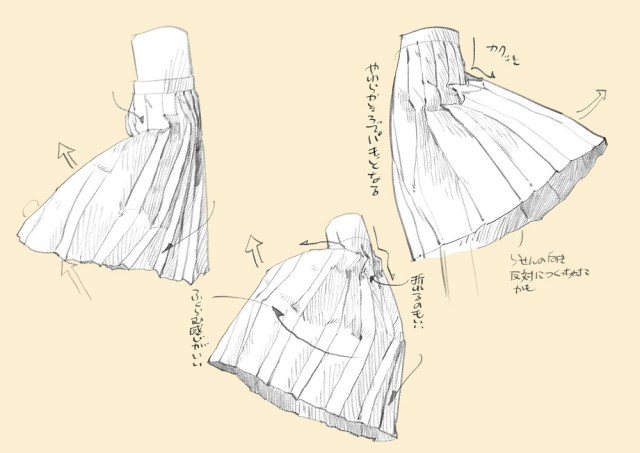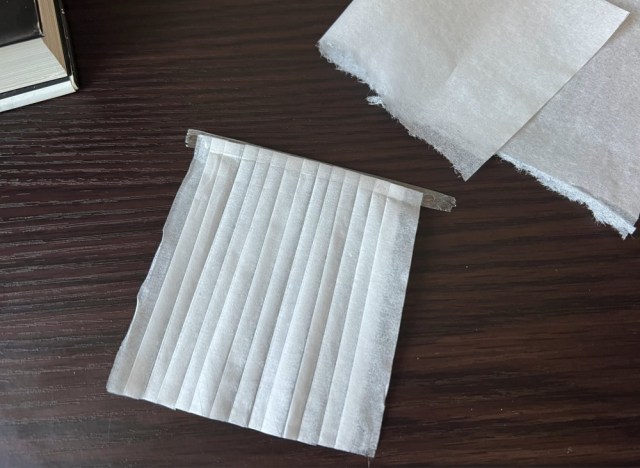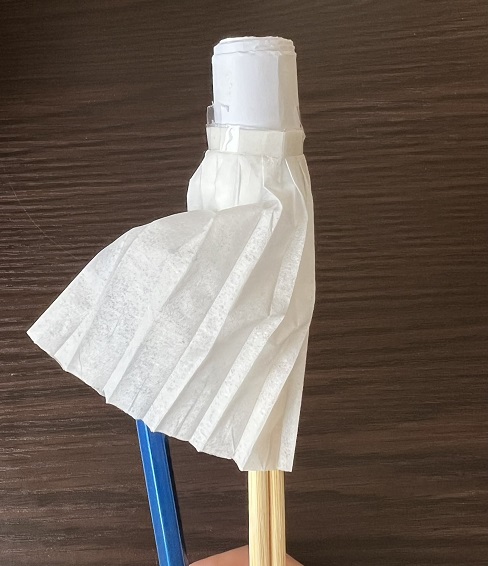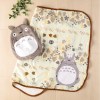
Having trouble making manga character’s pleated skirts look good? You can solve it with three things you probably have within arm’s reach.
For aspiring manga and anime artists, it’s not so much a question of if they’re going to draw a character in a skirt, but when. With so many stories having teen protagonists or school settings, it’s really only a matter of time until most illustrators find themselves crafting a scene that includes a female character wearing a skirt as part of a school uniform.
Pleated skirts aren’t necessarily easy to draw, though, since they’re actually a complex shape made up of a large number of fabric planes. Sure, if the character is standing straight up and still, all of those lines will be going in the same direction, but as soon as you’re working with more dynamic and expressive body language, or environmental factors such as dramatically blowing wind, the various folds and creases of the skirt need to start bending in their own individual ways, which can be hard to correctly envision in your mind’s eye and lead to awkward, unengaging artwork.
Thankfully, Japanese illustrator and Twitter user @simodasketch has an extremely quick and clever method to make a reference model for yourself, and all you’ll need is some tissue paper, a piece of tape, and a pair of chopsticks or a similarly sized cylinder substitute.
To start, take a piece of tissue paper and fold a series of creases. The exact number isn’t important, but you want to make sure the creases go all the way across the paper, mimicking the fabric of a pleated skirt. Once you’ve formed all the folds, take a piece of tape and attach it along the top edge.
Next, grab your chopsticks or substitute cylinder (pen, pencil, etc.) and start rolling paper around the top. Once it gets thick enough, wrap the folded tissue paper around it, and your skirt model is complete!
Ideally, you want to be able to wrap the “skirt” around the wad of paper at the top of the chopsticks (which is representing the character’s waist) without any overlap, so you can adjust the thickness of the wad or trim the skirt accordingly. It’s important to make sure the wad is noticeably thicker than the chopsticks, though, so that you can see how the skirt should billow and bend as it hangs down below the wearer’s hips. As long as you do that, all that’s left to do is to arrange the model so that it matches what you want to draw, then refer to how the tissue pleats look as you start your art’s linework.
The simple solution to a challenging illustration dilemma has other Twitter users impressed and grateful, with responses such as:
“I’ve always had so much trouble drawing skirts, to I wanna make one these right away!”
“This is going to be a huge help with a major roadblock I’ve been running into.”
“Are you a god?”
“The amazing power of tissues!”
“The model is pretty cute!”
スカートのシワが見たくてティッシュで作ってみた。 pic.twitter.com/yCKuYAYuEy
— 下田スケッチ【絵の描き方】 (@simodasketch) November 16, 2021
Theoretically, it seems like @simodasketch’s technique should work for skirts without pleats too, just as long as you don’t fold the tissue skirt before attaching it to the chopsticks, and it might even be helpful when drawing characters in kimono for historical manga, as long as you account for the reduced amount of drape compared to a skirt.
Of course, drawing characters and their costumes is only part of what goes into illustrating a scene, but this skirt model should help you get off to a good start, and if you need help keeping the background art consistent, this other clever idea might do the trick.
Source, images: Twitter/@simodasketch
● Want to hear about SoraNews24’s latest articles as soon as they’re published? Follow us on Facebook and Twitter!



 How to fold an entire origami schoolgirl, sailor suit and all, out of a single piece of paper
How to fold an entire origami schoolgirl, sailor suit and all, out of a single piece of paper Samurai parkas for men feature traditional washi Japanese paper details
Samurai parkas for men feature traditional washi Japanese paper details Glowing skirt lets you cosplay Hatsune Miku, show off your sexy thighs
Glowing skirt lets you cosplay Hatsune Miku, show off your sexy thighs How to make Ukrainian flag origami crane paper
How to make Ukrainian flag origami crane paper Foreigner’s request for help in Tokyo makes us sad for the state of society
Foreigner’s request for help in Tokyo makes us sad for the state of society Seaside scenery, history, and so many desserts on Yokohama’s Akai Kutsu【Japan Loop Buses】
Seaside scenery, history, and so many desserts on Yokohama’s Akai Kutsu【Japan Loop Buses】 Japanese city loses residents’ personal data, which was on paper being transported on a windy day
Japanese city loses residents’ personal data, which was on paper being transported on a windy day Should you add tartar sauce to Japanese curry rice? CoCo Ichi makes diners an unusual offer
Should you add tartar sauce to Japanese curry rice? CoCo Ichi makes diners an unusual offer Akihabara pop-up shop sells goods made by Japanese prison inmates
Akihabara pop-up shop sells goods made by Japanese prison inmates Mt. Koya planning to instate visitor’s tax to cope with huge tourist numbers
Mt. Koya planning to instate visitor’s tax to cope with huge tourist numbers Ghibli Park now selling “Grilled Frogs” from food cart in Valley of Witches
Ghibli Park now selling “Grilled Frogs” from food cart in Valley of Witches Japanese company uses “crow language” to keep them away from garbage 【Video】
Japanese company uses “crow language” to keep them away from garbage 【Video】 The picture-perfect cosplayers of Comiket 100’s Day 1【Photos】
The picture-perfect cosplayers of Comiket 100’s Day 1【Photos】 New Totoro, Catbus, and other Ghibli plushies transform from cushions to blankets【Photos】
New Totoro, Catbus, and other Ghibli plushies transform from cushions to blankets【Photos】 McDonald’s new Happy Meals offer up cute and practical Sanrio lifestyle goods
McDonald’s new Happy Meals offer up cute and practical Sanrio lifestyle goods Japanese ramen restaurants under pressure from new yen banknotes
Japanese ramen restaurants under pressure from new yen banknotes French Fries Bread in Tokyo’s Shibuya becomes a hit on social media
French Fries Bread in Tokyo’s Shibuya becomes a hit on social media Studio Ghibli releases new action figures featuring Nausicaä of the Valley of the Wind characters
Studio Ghibli releases new action figures featuring Nausicaä of the Valley of the Wind characters Red light district sushi restaurant in Tokyo shows us just how wrong we were about it
Red light district sushi restaurant in Tokyo shows us just how wrong we were about it New private rooms on Tokaido Shinkansen change the way we travel from Tokyo to Kyoto
New private rooms on Tokaido Shinkansen change the way we travel from Tokyo to Kyoto Tokyo Tsukiji fish market site to be redeveloped with 50,000-seat stadium, hotel, shopping center
Tokyo Tsukiji fish market site to be redeveloped with 50,000-seat stadium, hotel, shopping center Beautiful Ghibli sealing wax kits let you create accessories and elegant letter decorations【Pics】
Beautiful Ghibli sealing wax kits let you create accessories and elegant letter decorations【Pics】 Studio Ghibli releases Kiki’s Delivery Service chocolate cake pouches in Japan
Studio Ghibli releases Kiki’s Delivery Service chocolate cake pouches in Japan New definition of “Japanese whiskey” goes into effect to prevent fakes from fooling overseas buyers
New definition of “Japanese whiskey” goes into effect to prevent fakes from fooling overseas buyers Our Japanese reporter visits Costco in the U.S., finds super American and very Japanese things
Our Japanese reporter visits Costco in the U.S., finds super American and very Japanese things All-you-can-drink Starbucks and amazing views part of Tokyo’s new 170 meter-high sky lounge
All-you-can-drink Starbucks and amazing views part of Tokyo’s new 170 meter-high sky lounge More foreign tourists than ever before in history visited Japan last month
More foreign tourists than ever before in history visited Japan last month New Pokémon cakes let you eat your way through Pikachu and all the Eevee evolutions
New Pokémon cakes let you eat your way through Pikachu and all the Eevee evolutions Disney princesses get official manga makeovers for Manga Princess Cafe opening in Tokyo
Disney princesses get official manga makeovers for Manga Princess Cafe opening in Tokyo Sales of Japan’s most convenient train ticket/shopping payment cards suspended indefinitely
Sales of Japan’s most convenient train ticket/shopping payment cards suspended indefinitely Sold-out Studio Ghibli desktop humidifiers are back so Totoro can help you through the dry season
Sold-out Studio Ghibli desktop humidifiers are back so Totoro can help you through the dry season Japanese government to make first change to romanization spelling rules since the 1950s
Japanese government to make first change to romanization spelling rules since the 1950s Ghibli founders Toshio Suzuki and Hayao Miyazaki contribute to Japanese whisky Totoro label design
Ghibli founders Toshio Suzuki and Hayao Miyazaki contribute to Japanese whisky Totoro label design Doraemon found buried at sea as scene from 1993 anime becomes real life【Photos】
Doraemon found buried at sea as scene from 1993 anime becomes real life【Photos】 Tokyo’s most famous Starbucks is closed
Tokyo’s most famous Starbucks is closed One Piece characters’ nationalities revealed, but fans have mixed opinions
One Piece characters’ nationalities revealed, but fans have mixed opinions We asked a Uniqlo employee what four things we should buy and their suggestions didn’t disappoint
We asked a Uniqlo employee what four things we should buy and their suggestions didn’t disappoint Princesses, fruits, and blacksmiths: Study reveals the 30 most unusual family names in Japan
Princesses, fruits, and blacksmiths: Study reveals the 30 most unusual family names in Japan Japanese Twitter has its sanity saved with lifehack to deal with tissues left in your laundry
Japanese Twitter has its sanity saved with lifehack to deal with tissues left in your laundry You can rest your chopsticks on a lot of different things in Japan
You can rest your chopsticks on a lot of different things in Japan Manga artist shares a genius-level trick to take the headache out of drawing interior scenes
Manga artist shares a genius-level trick to take the headache out of drawing interior scenes New light-emitting, color-changing “hikaru skirt” illuminates your legs for the world to see
New light-emitting, color-changing “hikaru skirt” illuminates your legs for the world to see RocketNews24’s Meg models the entire line of Japan’s new schoolgirl outfit loungewear 【Photos】
RocketNews24’s Meg models the entire line of Japan’s new schoolgirl outfit loungewear 【Photos】 Enjoy the anniversary of the Evangelion Store with great new clothes and accessories
Enjoy the anniversary of the Evangelion Store with great new clothes and accessories Studio Ghibli now has a Hawaiian shirt and skirt collection【Photos】
Studio Ghibli now has a Hawaiian shirt and skirt collection【Photos】 New line of skirts promises to give you the slim waist and long legs of an anime heroine 【Photos】
New line of skirts promises to give you the slim waist and long legs of an anime heroine 【Photos】 Japanese artist shows amazing way to color illustrations: Let the fall leaves do it for you【Pics】
Japanese artist shows amazing way to color illustrations: Let the fall leaves do it for you【Pics】 Busty or boobless? Japanese Twitter debates which makes for more beautiful kimono anime art
Busty or boobless? Japanese Twitter debates which makes for more beautiful kimono anime art Manga materials website offers thousands of reference poses for budding artists to download
Manga materials website offers thousands of reference poses for budding artists to download The Japanese art of making trash containers from old papers
The Japanese art of making trash containers from old papers Anime voice actress is selling her used miniskirt…for US$690!
Anime voice actress is selling her used miniskirt…for US$690!
Leave a Reply